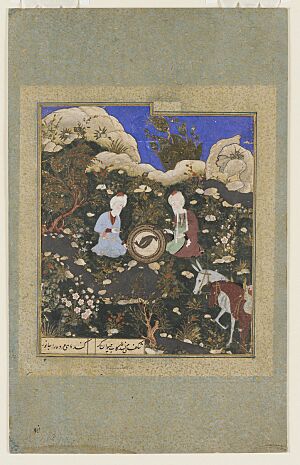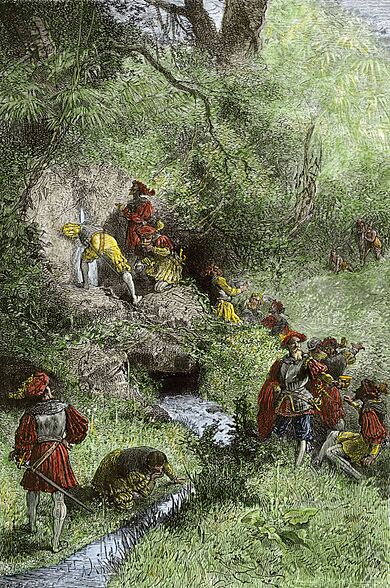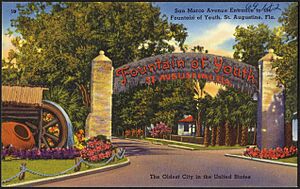Fountain of Youth facts for kids
The Fountain of Youth is a legendary spring. People believed that anyone who drank or bathed in its waters would become young again. Stories about such a fountain have been told for thousands of years all over the world.
Ancient writers like Herodotus (who lived in the 5th century BC) wrote about it. It also appeared in stories about Alexander the Great and in tales of Prester John during the Crusades. When European explorers came to the Caribbean in the early 1500s, the local people also spoke of magical waters. They talked about a land called Bimini where the water could make you young again.
Because of these many legends, explorers like Juan Ponce de León searched for the Fountain of Youth. They hoped to find a special river, spring, or other water source that could reverse aging and cure sickness. The legend became very famous in the 16th century, especially with Ponce de León. He was the first Governor of Puerto Rico. People said he was looking for the Fountain of Youth when he explored Florida in 1513. The legend claims that Native Americans told him the fountain was in Bimini.
Contents
Ancient Stories of Youthful Waters
Many old stories mention special waters that grant long life or youth.
The Macrobians' Fountain
The Greek historian Herodotus wrote about a fountain in the land of the Macrobians. He said this special water helped the Macrobians live for a very long time, often over 120 years. He described the water as making people's skin look shiny and smooth, and it smelled like violets. He also noted that the water was so light that nothing would float in it.
Alexander the Great and the Water of Life

In some Eastern stories about Alexander the Great, he and his servant search for the "Water of Life." They travel through a dark land to find this special spring. The servant in these stories is based on Al-Khidr, a wise figure from Middle Eastern legends. These stories were very popular in Spain during the time of Moorish rule. This meant that explorers heading to America likely knew these tales.
These old accounts also inspired a popular medieval fantasy book called The Travels of Sir John Mandeville. This book also mentions the Fountain of Youth. It says the fountain is at the bottom of a mountain in India. Because of these tales, the Fountain of Youth was a popular subject in medieval art. It appeared on things like ivory boxes and mirror cases. The legend stayed popular through the European Age of Exploration.
Other Myths of Eternal Youth
The idea of eternal youth is a common theme in myths and legends. Many cultures have stories about things like the philosopher's stone, which could turn metal into gold and create an elixir of life. An elixir of life is a magical drink that grants immortality. These stories are found across Europe and Asia.
Some people also think the story of the Pool of Bethesda might have inspired the legend. In the Gospel of John, this pool was said to be stirred by an angel. The first person to step into the water after it was stirred would be healed of any sickness.
Bimini and the Healing Hole
The Legend of Bimini
According to legend, the Spanish explorers heard about Bimini from the Arawak people. These islanders lived in places like Hispaniola, Cuba, and Puerto Rico. They described a mythical land called Beimeni or Beniny. This land was said to be rich and prosperous. Over time, this land became linked with the Fountain of Youth legend.
By the time Juan Ponce de León explored, people thought Bimini was located northwest, towards the Bahamas. The native people were probably talking about the area where the Maya lived. This land also got mixed up with another place called Boinca or Boyuca. This Boinca was originally said to have a legendary fountain of youth, not Bimini itself. A chief from Cuba named Sequene was supposedly drawn to Bimini and its healing fountain. He gathered adventurers and sailed north, but he never came back.
The Healing Hole in Bimini
Today, in the salt water mangrove swamp on North Bimini, there is a place called The Healing Hole. It's a pool at the end of winding tunnels. When the tide goes out, these tunnels pump cool, mineral-rich fresh water into the pool. This well was carved out of limestone rock by groundwater thousands of years ago. Because of this, the water is very high in calcium and magnesium. Magnesium is known to be good for health.
It's not clear if local people had widespread legends about healing waters. However, an Italian writer named Peter Martyr d'Anghiera wrote about such a story in 1516. He connected it to the voyage of Juan Diaz de Solis. Peter Martyr himself didn't believe these stories, but he was surprised that many others did.
Ponce de León and the Fountain

In the 1500s, the story of the Fountain of Youth became linked to the Spanish explorer Juan Ponce de León. His royal charter, which was his official permission to explore, tasked him with finding the land of Beniny. Even though the native people were probably describing the land of the Maya in Yucatán, the name and the legends became connected to the Bahamas.
However, Ponce de León himself never mentioned the Fountain of Youth in any of his own writings about his travels.
How the Legend Grew
The connection between Ponce de León and the fountain was first made in a book by Gonzalo Fernández de Oviedo y Valdés in 1535. He wrote that Ponce de León was looking for the waters of Bimini to become young again. Some historians think Oviedo might have written this to gain favor in the royal court. A similar story appeared in another book by Francisco López de Gómara in 1551.
Later, in 1575, Hernando d'Escalante Fontaneda wrote a memoir. He had been held captive by Native Americans in Florida for 17 years. In his memoir, he placed the healing waters in Florida. He mentioned Ponce de León looking for them there. Fontaneda called this lost river "Jordan." However, Fontaneda also made it clear that he doubted these stories. He said he didn't think Ponce de León was actually looking for the fabled stream when he came to Florida.
A writer named Antonio de Herrera y Tordesillas made the connection even stronger in his romanticized history. Herrera wrote that local chiefs regularly visited the fountain. He claimed that a weak old man could become completely restored. He could even "take a new wife and beget more children." Herrera added that the Spanish had searched every "river, brook, lagoon or pool" along the Florida coast for the legendary fountain, but they never found it.
Fountain of Youth Archaeological Park
The city of St. Augustine, Florida, has a place called the Fountain of Youth Archaeological Park. This park is a tribute to the spot where people believed Ponce de León landed. However, there is no real historical or archaeological proof that he landed there.
The property started as a tourist attraction in the 1860s. The park in its current form was created by Luella Day McConnell in 1904. She bought the land with cash and diamonds, which earned her the nickname "Diamond Lil." Around 1909, she started advertising the attraction. She charged admission and sold water from a well that had been dug in 1875. McConnell later claimed to have "discovered" a large cross made of rock on the grounds. She said Ponce de León himself had placed it there. She continued to make up stories to entertain people until she died in a car accident in 1927.
Walter B. Fraser then bought the property. He made it one of Florida's most successful tourist attractions. The first archaeological digs at the park happened in 1934. These digs found many Christianized Timucua burials. These burials showed that the park was the location of the first Christian mission in the United States. This mission, called the Mission Nombre de Dios, was started by Franciscan friars in 1587.
Over the years, more items have been found. These items confirm that the park is where Pedro Menéndez de Avilés started the settlement of St. Augustine in 1565. St. Augustine is the oldest continuously inhabited European settlement in North America. Today, the park displays native and colonial artifacts. It celebrates Ponce de León and Pedro Menéndez de Avilés, who founded St. Augustine. Exhibits about Timucua and Spanish heritage are also on display.
See also
 In Spanish: Fuente de la juventud para niños
In Spanish: Fuente de la juventud para niños
- Immortality
- Elixir of life
- Schiller Woods magic water pump


